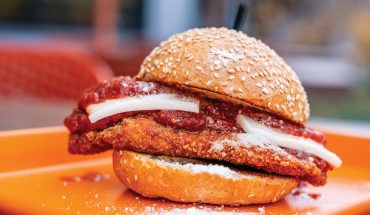Sean Fowler says: We cooked a Bourbon Red heritage turkey, prized for its darkly colored, richly flavored meat, from Cane Creek Farm. I grew up eating conventionally raised, frozen turkey, which can taste great if treated correctly, by brining and properly cooking. But if you have the inclination to spring for a free-range, heritage bird, it will be a game changer. Let me warn you – they are habit-forming and more expensive, and once you try one, you might not be able to go back.
1 14- to 15-pound free-range turkey
Brine:
1½ gallons water
1 head garlic, cut in half crosswise
4 sprigs rosemary
1 tablespoon whole white peppercorns
2 cups salt
1 cup granulated sugar
5 bay leaves
3 quarts ice
Combine all brine ingredients except ice in a stock pot and bring to a boil, stirring occasionally to dissolve the salt and sugar. Once brine boils, remove from the heat and add ice to cool it. Refrigerate until you are ready to brine the turkey.
Pour brine into a large stockpot or container that can hold it and the turkey. Submerge the turkey, weighting it down if necessary, and refrigerate for 24 hours. Remove turkey, discard brine and let turkey rest in the refrigerator about 2 hours before you begin to cook it.
Smoking (Optional): Using a smoker or grill, you can smoke your turkey to add flavor before roasting it. Follow instructions for your equipment and smoke the turkey for 30 minutes to 2 hours at 150 to 200 degrees. I like to get a deep golden brown on the exterior. Smoking will reduce roasting time from 15 minutes to an hour depending on the size of the turkey and the temperature and duration of your smoke.
Roasting: Roast your turkey at a gentle 325 degrees. The time will vary, depending on many factors, so stay flexible. Meat thermometers can be off by 20 degrees or more after knocking around in a kitchen drawer; calibrate yours by submerging in a glass of ice water and setting it at 32 degrees.
Place the turkey in a roasting pan on a rack or bed of chopped celery, carrots, and onions to shield it from the intense, direct heat of the pan and keep it out of its own juices. Cover the turkey with a tent of aluminum foil to prevent excessive browning. Uncover for the last 30 to 45 minutes to develop golden brown skin.
Once the turkey is in the oven, keep the oven closed as much as possible; this keeps the heat in and reduces cooking time. About 40 minutes from the estimates that follow, check the turkey’s temperature. Remove the roasting pan from the oven and close the oven door; insert thermometer into the thickest part of the leg. When it reads about 160 degrees, remove the turkey from the oven; it will reach the desired 165 degrees as it rests for 20 to 30 minutes.
While the turkey rests, heat your side dishes, arrange the buffet or table and pour everyone a fresh drink. By the time you herd everyone to the table, your turkey will be ready to carve.
Serves 8 to 10.
Estimated cooking times for turkeys
Weight Hours at 325 degrees
8 pounds 2 hours, 45 minutes
12 pounds 3 hours
14 pounds 3 hours, 45 minutes
18 pounds 4 hours, 15 minutes
20 pounds 4 hours, 30 minutes
Giblet Gravy
To make the gravy ahead of time, you’ll need a substitute for the drippings, such as chicken fat and rich chicken stock or a mix of that and duck fat.
About ¾ cup drippings from your turkey roasting pan
2 cups chicken stock
1 to 2 shallots, peeled and finely minced
Giblets (neck, gizzards, heart, liver, etc.) from your turkey
½ cup Wondra instant flour
½ cup dry vermouth
Salt and pepper to taste
1 teaspoon fresh thyme leaves
Heat pan drippings from turkey in a medium sauté pan. Warm chicken stock to a simmer in a small sauce pan. When drippings are hot, add shallots and cook over medium high heat until translucent, about a minute. Add giblets and cook for 3 minutes.
Whisk flour into mixture, adding enough to form a paste that’s the consistency of wet sand. Reduce heat to low and cook roux about 4 minutes.
Slowly add simmering chicken stock to the roux, whisking constantly and pouring slowly to avoid lumps. Continue cooking over low heat about 5 minutes.
Pour vermouth into now-empty saucepan (that once held chicken stock), bring to a boil and cook until reduced by half. Add reduced vermouth to the gravy.
Season with salt and pepper and thyme. Remove giblets and either discard, or chop very finely and return to gravy.
Makes about 2 1/2 cups.
Cranberry Gelatin Salad
2 cups orange juice
1 cup granulated sugar
4 cups fresh cranberries
4 envelopes unflavored gelatin
1 ½ cups diced fresh pineapple
1 cup shelled pistachio nuts
¾ cup mascarpone cheese
1 cup crème frâiche (or sour cream)
½ cup honey
Mint leaves, for garnish
In a medium saucepan, bring orange juice to a simmer. Whisk in sugar until dissolved and add cranberries. Raise heat to medium and cook until cranberries are soft but still hold their shape, about 5 minutes.
Remove about half of cranberries from saucepan and reserve. Puree remaining cranberry-orange mixture in a blender until smooth. Return mixture to saucepan. Make sure liquid is hot.
Whisk gelatin into hot orange mixture until dissolved. Remove from heat and stir in pistachios, pineapple and reserved whole cranberries.
Ladle mixture into ramekins or martini glasses and refrigerate, uncovered, overnight to set.
Combine mascarpone, crème fraiche and honey in the bowl of an electric mixer. Use the whisk attachment and blend until smooth, about 3 minutes on medium speed.
To serve, spoon a dollop of the cream mixture onto each portion, garnish with mint sprig and serve.
Serves 6 to 8.
Savory Apple-Leek Bread Pudding
This can be made in the morning and refrigerated. Bring to room temperature before baking.
2 loaves brioche or other rich, buttery bread
4 tablespoons bacon fat
1 1/2 quarts heavy cream
7 large egg yolks
1 ½ tablespoons thyme leaves (picked from the stem)
1 tablespoon minced fresh rosemary leaves
1 teaspoon grated nutmeg
2 teaspoons salt
1½ teaspoons ground black pepper
1 tablespoon vegetable oil
2 cups julienned leeks,
white and pale green parts only (about 3 leeks)
2 cups diced celery
3 apples (Honeycrisp, Pink Lady or Stayman), peeled, cored and diced and held in 4 cups of water containing the juice of 2 lemons
3 tablespoons softened butter, for the pan
Dice brioche into 1/2-inch cubes and reserve in a large mixing bowl. You need 12 cups.
Using the microwave, melt the bacon fat in a large bowl, then whisk in the cream and egg yolks. Whisk in thyme, rosemary, nutmeg, salt, and pepper. Set custard aside.
Heat vegetable oil in a medium sauté pan and cook leeks over medium heat until just softened, about 2 minutes. Set aside.
Butter a deep 9- by 13-inch casserole dish, such as a lasagna pan.
Add celery and leeks to bread cubes and toss to combine. Drain apples and add to the bread mixture. Toss lightly to evenly incorporate all of the ingredients. Loosely pack mixture into casserole dish.
Lightly whisk custard and pour evenly over bread. Firmly press bread mixture into the pan until tightly packed. Nearly all of the bread should be soaking in the custard. Cover tightly with foil.
Preheat oven to 325 degrees; bake bread pudding, covered, for 45 minutes. Remove cover and bake an additional 15 minutes or until the custard is set and the pudding is golden brown on top. Remove from oven, allow to cool for 10 minutes, and serve.
Serves 8 to 10.
Sean’s New Green Bean Casserole
The casserole can be made a day ahead, cooled and refrigerated, covered, overnight. Bring it to room temperature before baking. The shallot garnish needs to be prepared on serving day.
2 pounds tender green beans, stem ends removed
1 1/2 quarts chicken stock
¼ cup vegetable oil
3 cups sliced shiitake mushrooms
3 cups sliced cremini mushrooms
½ pound (2 sticks) unsalted butter
½ cup Wondra instant flour
1 ½ teasoons salt
1 teaspoon ground white pepper
Fried shallots:
6 shallots, peeled and sliced into rings
2 cups buttermilk
Vegetable oil for frying
3 cups Wondra instant flour
1 teaspoon salt
1 teaspoon ground white pepper
½ teaspoon onion powder
Vegetable oil for frying
In a large pot, stir 1 cup salt into 1 gallon of water and bring to a rapid boil over high heat. Fill a large bowl with ice and water and set aside. Add the green beans to boiling water and cook for 2 minutes; remove beans from water and plunge into the ice bath to stop the cooking and retain their bright green color
When chilled, remove beans from ice bath and reserve.
Heat chicken stock to a simmer in a saucepan.
Heat vegetable oil in a large skillet and saute mushrooms over medium heat until they begin to soften. Add butter to mushrooms and let it melt, stirring occasionally.
Sift flour into butter and stir to form a roux. Cook over medium heat for 2 minutes. Stirring constantly, add hot chicken stock to mixture.
Simmer mushroom gravy for 4 minutes, or until thickened. Remove from the heat and allow to cool slightly.
Gently stir green beans into mushroom gravy, and pour mixture into a 9- by 13-inch casserole. Cool, cover and refrigerate if working ahead.
Fried shallots: Separate shallot slices into individual rings and soak in buttermilk for 15 minutes.
Heat oil to 350 degrees in deep fryer or deep, heavy pot pot.
Combine flour, salt, pepper and garlic powder.
Remove shallots from buttermilk and drain excess liquid. Toss in seasoned flour until thoroughly coated.
Making sure oil is at 350 degrees, work in batches and fry shallot rings until golden brown, about 1 minute. Strain from oil and lay rings in an even layer on a tray lined with paper towels. The rings will crisp up slightly when cooled. Store in a warm, dry part of the kitchen until ready to use.
To finish: Heat oven to 325 degrees and bake covered casserole about 40 minutes, or until bubbling and hot in the center. Remove foil and spread fried shallot rings over the top. Return to oven and cook another few minutes to warm and crisp the shallots.
Serves 10 to 12.




